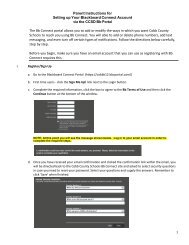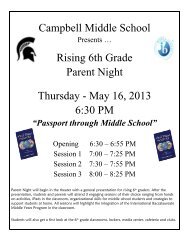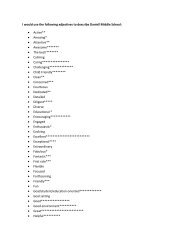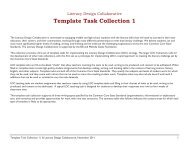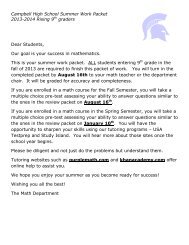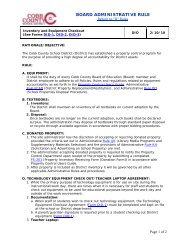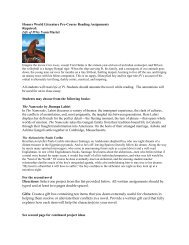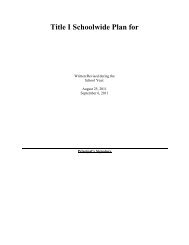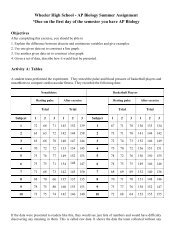Title I Schoolwide Plan - Cobb County School District
Title I Schoolwide Plan - Cobb County School District
Title I Schoolwide Plan - Cobb County School District
- No tags were found...
You also want an ePaper? Increase the reach of your titles
YUMPU automatically turns print PDFs into web optimized ePapers that Google loves.
<strong>Title</strong> I <strong><strong>School</strong>wide</strong> <strong>Plan</strong> for. Barber Middle <strong>School</strong> .Name of <strong>School</strong>Written/Revised during the<strong>School</strong> Year: 2011- 2012 for the 2012-2013 <strong>School</strong> Year<strong>Plan</strong> Submitted:May 2, 2012RevisedMay 8, 2012October 9, 2012Principal’s Signature (Required)Revision Dates: May 8, 2012; October 9, 2012; November 14, 2012;<strong>Cobb</strong> <strong>County</strong> <strong>School</strong> <strong>District</strong> Revised 4/27/121 | P a g e
<strong>Title</strong> I <strong><strong>School</strong>wide</strong> <strong>Plan</strong><strong>Plan</strong>ning Committee Members for <strong><strong>School</strong>wide</strong> <strong>Plan</strong>s ReviewDate of Meeting:_______Name of <strong>School</strong> ________________________________________NAME POSITION/ROLE/PARENT SIGNATUREAlexander, Melanie SS Department ChairAndrea, LinetteBennett, MichaelBurroughs, Mark<strong>Cobb</strong>, AjahCollins, JeannieGallman, ErikaGentry, TeiaGrimes, HannaJacalyn RuhKline, KarenNyeste, LenoraSalzman, LaraShaw, AmandaSimington, MelanieSpencer, CrystalTalley, CourtneyTaylor, BowerThorpe, ShannonWilliams, LisaParent Liaison/ParaprofessionalAdv. Content Department ChairConnections Department ChairParentAssistant AdministratorParentAssistant PrincipalMedia SpecialistSpecial Education DepartmentChairMath Department ChairAssistant Principal<strong>School</strong> CounselorAcademic Coach: Math and ScienceParent<strong>School</strong> CounselorScience Department ChairLA Department ChairAcademic Coach: LiteracyPrincipal<strong>Cobb</strong> <strong>County</strong> <strong>School</strong> <strong>District</strong> Revised 4/27/122 | P a g e
Table of Contents1. Comprehensive Needs AssessmentA. Participation of Individuals……………………………………………B. Instruments, Procedures, or Processes…………………………………C. The Needs of Homeless, Neglected, and Migrant Children……………D. Current Achievement Data……………………………………………..E. Information about All Students………………………………………...F. Data, Conclusions (Summary of Needs)………………………………G. Measurable Goals/Benchmarks………………………………………...2. <strong><strong>School</strong>wide</strong>H. H.Reform Strategies that are Scientifically ResearchedhhhA. <strong><strong>School</strong>wide</strong> Reform Strategies That Provide Opportunities For AllI.Children………………………………………………………………..J.B.Data,EffectiveConclusions………………………………………………………Means of Raising Student Achievement…………………….K.C. Effective Instructional Methods That Increase Learning Time………...D. Address the Needs of All Children……………………………………..3. Instruction by Highly Qualified Professional StaffA. Strategies to Attract Highly Qualified Teachers……………………….B. <strong>School</strong> Status of Highly Qualified Teachers…………………………...4. Professional Development for StaffA. Include Teachers, Principals, Paraprofessionals, and Others…………L. B. Aligned Professional Development with the State’s AcademicM. Measurable Content…………………………………………………………………Goals/Benchmarks………………………………………...C. Professional Development Activities that Address the Root Causes…..D. Include Teachers in Professional Development Activities Regardingthe Use of Academic Assessments……………………………………..………………………………………………..E. <strong>School</strong>s Yearly Professional Development Schedule………………….5. Strategies to Increase Parental InvolvementA. Involved Parents in the <strong>Plan</strong>ning of the Comprehensive <strong><strong>School</strong>wide</strong>Program………………………………………………………………...B. Parent Involvement Policy and Parent Compact………………………6. <strong>Plan</strong>s for Assisting Preschool Children in the Transition from Early ChildhoodPrograms, Elementary and/or Students Entering Middle <strong>School</strong> or High<strong>School</strong>………………….7. Measures to include Teachers in the Decisions Regarding the Use ofAssessment……………………………………………………………………..Pages591415171920<strong>Cobb</strong> <strong>County</strong> <strong>School</strong> <strong>District</strong> Revised 4/27/123 | P a g e
8. Coordination and Integration of Federal, State, and Local Services andProgramsA. List of State and Local Educational Agency Programs and OtherFederal Programs that will be Included………………………………B. Description of How Resources from <strong>Title</strong> I and Other Sources will beUsed……………………………………………………………………C. <strong>Plan</strong> Developed in Coordination with Other Programs………………..9. Activities to Ensure that Students who Experience Difficulty MasteringStandards shall be Provided with Effective , Timely AssistanceA. Measures to Ensure that Students’ Difficulties are Identified on aTimely Basis……………………………………………………………B. Periodic Training for Teachers in the Identification of Difficulties……C. Teacher-Parent Conferences……………………………………………202110. Description of how Individual Student Assessment Results will be providedto Parents………………………………………………………………………. 2211. Provisions for the Collection and Disaggregation of Data……………………. 2212. Provisions to Ensure the Disaggregated Assessment Results are Valid andReliable…………………………………………………………………………13. Provisions for Public Reporting of Disaggregated Data……………………… 2314. <strong>Plan</strong> Developed During a One-Year Period…………………………………... 2315. <strong>Plan</strong> Developed with the Involvement of the Community to be Served……… 2316. <strong>Plan</strong> Available to the LEA, Parents, and the Public…………………………... 2417. <strong>Plan</strong> Translated………………………………………………………………... 2418. <strong>Plan</strong> is Subject to the <strong>School</strong> Improvement Provisions of Section 1116 ……... 2423<strong>Cobb</strong> <strong>County</strong> <strong>School</strong> <strong>District</strong> Revised 4/27/124 | P a g e
1. Comprehensive Needs Assessment.A. Participation of IndividualsThe school wide plan has been developed with the participation of individualswho will carry out the comprehensive schoolwide/school improvement programplan.The team included parent representatives and representatives from all gradelevels, content areas, and support services who worked collaborativelythroughout the 2011-2012 school year to develop the school-wide plan. Theindividuals involved, their titles, and their key roles are identified below.NAMEAlexander, MelanieAndrea, LinetteBennett, MichaelBurroughs, Mark<strong>Cobb</strong>, AjahCollins, JeannieGallman, ErikaGentry, TeiaGrimes, HannaJacalyn RuhKline, KarenNyeste, LenoraSalzman, LaraShaw, AmandaSimington, MelanieSpencer, CrystalTalley, CourtneyTaylor, BowerThorpe, ShannonWilliams, LisaROLESS Department ChairParent Liaison/ParaprofessionalAdv. Content Department ChairConnections Department ChairParentAssistant AdministratorParentAssistant PrincipalMedia SpecialistSpecial Education Department ChairMath Department ChairAssistant Principal<strong>School</strong> CounselorAcademic Coach: Math and ScienceParent<strong>School</strong> CounselorScience Department ChairLA Department ChairAcademic Coach: LiteracyPrincipalB. Instruments, Procedures, or ProcessesThe <strong>School</strong>-Wide <strong>Plan</strong>ning team has used the following instruments, procedures,or processes to obtain this information:o Georgia Criterion Reference Test (CRCT)<strong>Cobb</strong> <strong>County</strong> <strong>School</strong> <strong>District</strong> Revised 4/27/125 | P a g e
o Iowa Test of Basic Skills (ITBS)o Lexile Scoreso Georgia Department of Education <strong>School</strong> AYP Reporto Georgia Department of Education <strong>School</strong> Report Cardo <strong>School</strong> Summary Reports-CRCT and Middle Grades Writing Assessmento <strong>School</strong> Strategic <strong>Plan</strong>o <strong>Title</strong> II <strong>Plan</strong>o <strong>School</strong> Climate Survey ResultsC. The Needs of Homeless, Neglected and Migrant ChildrenThe <strong>School</strong>-Wide <strong>Plan</strong>ning Team has taken into consideration the needs ofmigrant children by working with the International Welcome Center (IWC) for theschool district to ensure these students’ individual needs are met. At this time,Barber Middle <strong>School</strong> does not serve any students identified as migrant. Theneeds of homeless and neglected students are met through programs wecoordinate with our Homeless Liaison at the district level. The counselingdepartment and administration work closely to identify, monitor, andcommunicate with these families and other individuals to provide the resourcesrequired to ensure an adequate educational experience for those students in need.D. Current Achievement DataThe <strong>School</strong>-Wide <strong>Plan</strong>ning Team has reflected current achievement data that willhelp the school understand the subjects and skills in which teaching and learningneed to be improved as follows:1. Math is consistently the area of weakest performance for Barber Middle <strong>School</strong>students. The student population as a whole has failed to meet acceptablestandards over the past four years, with only 74% meeting standards in 2008-2009, 76% in 2009-2010, 85% in 2010-2011, and 82% in 2011-2012. Anexamination of separate student groups’ performance on the 2011-2012 CRCTreveals gaps in achievement. A comparison of black and white students indicatesan 7% difference with only 77% of black students meeting/exceeding standardswhile 84% of white students met/exceeded standards. Additionally, the percentageof students meeting/exceeding among economically disadvantaged (78%), EnglishLanguage Learners (ELL) (82%), and students with disabilities (61%) indicates asignificant gap in achievement in comparison with other students.2. Although English/Language Arts is an area where Barber Middle <strong>School</strong>students have consistently met academic standards, when compared to otherstudent groups, students with disabilities are not meeting standards at the samerate. For all other student groups, 94-100% of students met/exceeded standardson the CRCT. Only 78% of students with disabilities met standards and noneexceeded.3. Although Barber Middle <strong>School</strong> students as a whole have improvedperformance on the Middle Grades Writing assessment since 2008, students withdisabilities have regressed. Additionally, students with disabilities have failed to<strong>Cobb</strong> <strong>County</strong> <strong>School</strong> <strong>District</strong> Revised 4/27/126 | P a g e
perform commensurate with other students. Only 50% of students with disabilitiesmet/exceeded the target in 2012, 41% in 2011, 57% in 2010 and 62% in 2009.4. An analysis of CRCT results in the area of science over the past four yearsshows that 74% (2008-2009), 76% (2009-2010), 79% (2010-2011), and 78%(2011-2012) of students met or exceeded standards in science. Furthermore,longitudinal data indicate that students make gains in science achievementbetween 6 th and 7 th grades yet regress in 8 th grade. In 2008-2009, 74% of 6 thgrade students met/exceeded standards. The following year, 80% of 7 th gradestudents met/exceeded standards. In 2009-2010, only 69% of 8 th grade studentsmet/exceeded standards. Historically, students make academic gains in 7 th gradeand drop in 8 th grade.E. Information about All StudentsThe <strong>School</strong>-Wide <strong>Plan</strong>ning Team has based the plan on information about allstudents in the school and identified students and groups of students who are notyet achieving to the State Academic content standards and the State studentacademic achievement standard includingEconomically disadvantaged students are failing to meet standards in math.Data analysis of students from Major racial and ethnic groups point to anachievement gap between black students and all other racial or ethnicsubgroups at Barber Middle <strong>School</strong> in the area of math.Students with disabilities are identified as the subgroup with the highestnumber of students not yet achieving the State Academic content standardsthat affected the AYP status of Barber Middle <strong>School</strong> (Math,English/Language Arts)Students receiving support with Limited English (LEP) are significantlybehind all other groups of students at Barber Middle <strong>School</strong>.Students at large are failing to meet adequate levels of achievement in thearea of science.Historically, 8 th grade students have the lowest achievement rates in the areaof science than both other grades.The rate of student absent for 15 days or more has been consistent for thepast two years with approximately 6% of students absent 15 days or more.However, students with disabilities and ELL students rate of absenteeismincreased from 2009-2010 to 2010-2011. Additionally, students identified aseconomically disadvantaged posted a 1% increase in the percentage ofstudents absent 15 days or more.F. Data, Conclusions (Summary of Needs)The data has helped the team reach conclusions regarding achievement or otherrelated data. The major strengths discovered were:o Students at Barber Middle <strong>School</strong> have demonstrated excellent performanceon the Middle Grades Writing Assessment. A greater percentage of Barber<strong>Cobb</strong> <strong>County</strong> <strong>School</strong> <strong>District</strong> Revised 4/27/127 | P a g e
ostudents met/exceeded the target in 2011 than the percentage of studentswithin the <strong>Cobb</strong> <strong>County</strong> <strong>School</strong> <strong>District</strong>, Metro RESA, and the state ofGeorgia. The percentage of students meeting/exceeding was as follows: 2009(86%), 2010 (85%), 2011 (92%). BMS students dropped slightly in 2012 withonly 84% of students meeting or exceeding target.Students at Barber Middle <strong>School</strong> consistently achieve standards in ELA,with 94% of students meeting/exceeding standards each year since 2008-2009. In 2012, 95% of BMS students met/exceeded standards in ELA.o In science and math, 7 th grade students have out-perform other grade levelseach year since 2008-2009. The same was true for 7 th grade students in 2011-2012. There was an overall increase from 79% (2011)to 83% of studentsmeeting/exceeding standards in 2012.The major needs discovered were:o Barber Middle <strong>School</strong> (BMS) students have historically underperformed in thearea of mathematics on the Georgia Criterion Reference Competency Test.There exists a significant achievement gap between the performance ofstudents with disabilities and all other students, and the gap has widened.Only 57% of BMS SWD met/exceeded standards in 2011 and in 2012, whichrepresents a 25% and 28% gap in achievement when comparing the twostudent groups.o In a comparison of BMS students and students in the district at large, there isa notable discrepancy in the percentage of students meeting or exceedingstandards in math as well. Although BMS students showed a 4% increase inthe percentage of students meeting/exceeding standards (from 79% in 2011 to83% in 2012, a smaller percentage of BMS students met/exceeded standardsthan CCSD students at large (87%).oMathematics instruction must meet the needs of all students, specificallystudents identified as economically disadvantaged, students with disabilities,and black students.o Student attendance, particularly that of students with disabilities, EnglishLanguage Learners, and economically disadvantaged students needs to bemonitored closely. Incentive programs need to be continued to promotepositive attendance patterns.The needs to be addressed are:o The teachers’ ability to increase technology integration in math and sciencefor increased student engagement for academic achievement.o The teachers’ ability to collaboratively plan instruction utilizing researchbasedstrategies and programs, including increased technology integration,to support all students.o The teachers’ ability to effectively develop and implement a balancedassessment plan for instructional planning and increased opportunities forstudents to demonstrate what they are expected to know, understand, and beable to do, specifically utilizing available technology.<strong>Cobb</strong> <strong>County</strong> <strong>School</strong> <strong>District</strong> Revised 4/27/128 | P a g e
o The teachers’ ability to collaboratively analyze student work samples, providecontent-related feedback, demonstrating exemplary performance in eachsubject area.o The teachers’ ability to collect, analyze, and use instructional andachievement data for instructional planning and re-delivery.o The students’ ability to answer factual, inferential, higher order thinkingquestions, and the ability to transfer subject knowledge across the entirecurriculum.o The specific academic needs of those students that are to be addressed in theschool wide program plan will be the lack of fundamental skills that shouldhave been mastered prior to beginning the State Academic content standards.o Increased parental involvement in all aspects of the school.The ROOTCAUSE/s discovered for each of the needs were:o Gaps in student achievement in math and science within feeder elementaryschools in the attendance pattern.o Gaps in student achievement in math and science between feeder elementaryschools in the attendance pattern.o Lack of parent involvement in students’ educationo Lack of mastery of fundamental skills in math and scienceG. Measurable Goals/BenchmarksThe measurable goals/benchmarks established to address the needs are:1. Increase the percentage of students meeting/exceeding standards inmathematics on the CRCT by at least 2%.2. Decrease by at least 2% the gap in achievement in mathematics on the CRCTbetween black and white students.3. Increase by at least 2% the percentage of economically disadvantagedstudents, students with disabilities, and ELL students meeting/exceedingstandards in mathematics on the CRCT.4. Increase by at least 4% the percentage of students with disabilities meeting orexceeding standards on the ELA portion of the CRCT.5. Increase by at least 5% the percentage of students with disabilities meeting orexceeding standards on the Middle Grades Writing Assessment.2. <strong><strong>School</strong>wide</strong> Reform Strategies that are Scientifically Researched.A. <strong><strong>School</strong>wide</strong> Reform Strategies that provide Opportunities for all Children Barber will address the needs of all children in the school particularly the needsof students furthest away from demonstrating proficiency related to the State’sacademic content and student academic achievement standard by incorporating<strong>Cobb</strong> <strong>County</strong> <strong>School</strong> <strong>District</strong> Revised 4/27/129 | P a g e
Language!, READ 180, ESOL services, Extended Day Program, Saturday SuccessAcademy, Fraction Nation, Fastt Math, and The Gifted and Talented Education(GATE) Program which allows students opportunities to enhance their abilitylevels at a much higher success rate. Additionally, the SWD Task Force targetingMath achievement has been formed.The instructional plan will also focus mathematics instruction in new andinnovative ways by integrating hands-on, differentiated lessons to more activelyengage students in the application of math concepts. Because there are manystudents who have gaps in their understanding of math concepts or who lack theskills for application of concepts in other disciplines, teachers must utilizecreative approaches to allow students to review, preview, and apply concepts tocreative and hands on problems. Technology affords students those opportunities.Specific iPad apps and Smart Board lessons can be designed and implemented tomake learning math more concrete, thereby dissolving abstract confusion thatsome students experience. Since middle grades students are accustomed totechnology in everyday life, it is predictable that they will find increasedopportunities to engage with content standards if allowed to manipulate conceptsthrough the use of technology.In order to change the routines and practices from passive learning to more activeengagements in learning, BMS wants to equip each math teacher with an iPad anda Smart Board and related professional learning. With such tools, teachers willlearn new and innovative ways to implement Common Core Standards wherestudents take their learning to higher levels of application. Additionally, teacherswill be able to extend the boundaries of their classrooms by posting iPad andSmart Board “mini-lessons” to their blogs each day to either preview newlearning or to review learning from the day’s lesson. This tool will be powerful forequipping parents to view the mini lessons and help their children with their mathhomework.MATH CONNECTIONS TEACHERo Barber will hire a math teacher to provide additional math instruction tosupplement grade-level mathematics instruction during the connectionsperiods for all three grades.ACADEMIC COACHESo Barber will hire two math coaches: one to support literacy and one tosupport mathematics. The coaches’ duties and responsibilities will includemodeling/teaching lessons; providing professional learning, providingcoaching support for teachers; providing support for RTI and retentionstrategies to support struggling learners; providing support for extendedlearning programs; providing support for supplemental learningprograms such as Write Source, FasttMath, and Fraction Nation.<strong>Title</strong> I funds will be utilized to purchase additional technological resources toincrease student engagement, encourage higher order thinking skills, increase<strong>Cobb</strong> <strong>County</strong> <strong>School</strong> <strong>District</strong> Revised 4/27/1210 | P a g e
technology integration, improve differentiated instruction in the areas of math,science, and language arts.<strong>Title</strong> I funds will be utilized for staff attendance at local, state, and federalconferences.<strong>Title</strong> I funds will be utilized for professional learning, to provide substitutes forrelease time for teacher collaboration for data review & analysis and lessondevelopment for improved student achievement in math, science, and languageartsB. Effective Means of Raising Student AchievementDifferentiated Instruction (Marzano):Citation: Marzano, R.J., Pickering, D.J. and Pollock, J.E. (2001). ClassroomInstruction That Works. Alexandria, VA: ASCD.Researchers at Mid-continent Research for Education and Learning (McREL)have identified nine instructional strategies that are most likely to improve studentachievement across all content areas and across all grade levels. These strategiesare explained in the book Classroom Instruction That Works:1. Identifying similarities and differences2. Summarizing and note taking3. Reinforcing effort and providing recognition4. Homework and practice5. Nonlinguistic representations6. Cooperative learning7. Setting objectives and providing feedback8. Generating and testing hypotheses9. Cues, questions, and advance organizersCRISS (CReating Independence through Student-owned Strategies):Citation: Project CRISS (2010) Retrieved November 16, 2011, fromhttp://www.projectcriss.com/central/publications-and-newsletters/CRISS involves graphic organizers, story boards, and graphs that help studentsacquire and apply knowledge through independent work. This gives them a chanceto take ownership of their learning.McRel:Citation: McRel (2011) Retrieved November 16, 2011, http://www.mcrel.org/READ 180:Informational reading strategies broken up for each specific subject area. Thisincludes graphic organizers, summarizing strategies, vocabulary andinformational text strategies specific to concerns of reading in each subject.<strong>Cobb</strong> <strong>County</strong> <strong>School</strong> <strong>District</strong> Revised 4/27/1211 | P a g e
Citation: READ 180 (2010) Retrieved November 16, 2011, fromhttp://read180.scholastic.com/reading-intervention-programREAD 180 comprehensive research based reading intervention software programthat helps improve reading proficiency, reading, and vocabulary skills, readingcomprehension, and writing. As a comprehensive reading intervention program,READ 180’s instructional strategies are extensive. Scholastic provides specificprogram and activities that support the content, design, and instructional methodsand strategies for these areas: Phonemic Awareness, Phonics and Syllabication,Fluency, Vocabulary, Comprehension, Spelling, Writing, Technology andinstruction for teaching ad motivating English-Language Learners. Additional,READ 180 provides target skills instruction for the core subjects of Reading andLanguage Arts. READ 180 is correlated to state standards and will effectivelyreinforce and support the regular curriculum. Targeted students will participate inREAD 180 on a daily basis in an elective class. Other targeted students willparticipate in a weekly session.FASTT Math:Citation: FASTT Math (2011) Retrieved November 16, 2011, fromhttp://teacher.scholastic.com/math-fact-fluency/fastt-math/index.htmlThe FASTT Math intervention program uses the research-validated FASTT system(Fluency and Automaticity through Systematic Teaching with Technology) to helpall students develop fluency with basic math facts. FASTT Math assesses allstudents to uncover fluency gaps and to establish a baseline of fluency for eachstudent. Then, FASTT Math automatically differentiates instruction in customized,10-minute daily sessions. FASTT Math ensures that all students, regardless of theirfluency level, build the long-lasting fluency they will need to tackle higher-ordermath. In addition to using FASTT Math in the Math Connections class, studentswill participate in FASTT Math during homeroom pullout and extended dayactivities. FASTT Math is installed in the <strong>Title</strong> I Resource Room, all GeneralEducation and SPED math classrooms, and the In-<strong>School</strong> Suspension.Research:The FASTT Math approach has been validated over several years of research withboth non-struggling and struggling students. In the study, depicted on the right,math delayed students who used the FASTT Math approach increased their fluencyby more than 70%. Those students who received no intervention showed nogrowth.Fraction Nation:Citation: Fraction Nation (2011) Retrieved November 16, 2011, fromhttp://teacher.scholastic.com/math-fact-fluency/fastt-math/index.html<strong>Cobb</strong> <strong>County</strong> <strong>School</strong> <strong>District</strong> Revised 4/27/1212 | P a g e
Fraction Nation uses the research-validated principles that drive fractioninstruction and deliver fraction fluency. The program is anchored in four coreresearch foundations: Strong Visual Models, Computation with Understanding,Support for Cognitive Processing, and Worked Examples. Fraction Nationautomatically differentiates instruction in customized, 10-minute daily sessions. Itensures that all students, regardless of their fluency level, build the long-lastingfluency they will need to tackle higher-order math. In addition to using FractionNation in the Math Connections class, students will participate in Fraction Nationduring homeroom pullout and extended day activities. Fraction Nation is installedin the <strong>Title</strong> I Resource Room, all General Education and SPED math classrooms,and the In-<strong>School</strong> Suspension.C. Effective Instructional Methods that increase Learning TimeIncreased Technology Integration: The Common Core Georgia PerformanceStandards (CCGPS) are expected to enhance the Georgia Performance Standards(GPS) to ensure a world-class curriculum to prepare Georgia students for college orcareers. The CCGPS establish knowledge and skills students should develop withintheir K-12 school years to fully prepare them as graduates for college and careers.The standards include “rigorous content and application of knowledge through highorderthinking skills.” Specifically, the middle school mathematics standards providerich and coherent preparation for high school math (Edutopia, 2008). As posted onthe Georgia Department of Education website, “…the primary goal of the Ed Techprogram is to improve student academic achievement through the use of technology. Itis also designed to assist every student in crossing the digital divide by ensuring thatevery student is technologically literate by the end of eighth grade, and to encouragethe effective integration of technology with teacher training and curriculumdevelopment to establish successful research-based instructional methods.” (GeorgiaDepartment of Education, 2010)Teachers who empower students to access information using technology teachthem that there are very few limits to accessing information and connecting withothers. Such teachers develop students who comprehend social skills for working withpeople they will never meet personally. They also help students understand the needfor personal responsibility for learning in classrooms where the solid walls of a schoolbuilding are not boundaries for learning (November, 2001).Effective technology integration across all disciplines requires activeengagement using technology routinely in a manner that supports curriculum goals.As an added benefit, when teachers use technology tools, students are more likely tostay on task, minimizing disruptive behaviors. Technology allows teachers to enhancetheir roles of advisor and coach while making learning more meaningful and fun.Technology integration helps students develop skills necessary to survive in acomplex, highly-technical, information-based economy. Technology integration mustoccur in ways that research shows enhance and deepen the learning process(Edutopia, 2008).Without a strong vision coupled with thoughtful and creative teachers,technology is not likely to improve learning (November, 2001). November (2001)<strong>Cobb</strong> <strong>County</strong> <strong>School</strong> <strong>District</strong> Revised 4/27/1213 | P a g e
discusses the difference between automating and informating as two separate ways ofthinking about technology. While automating is essentially attaching technology tocurrent practices, informating is a shift in control and empowerment. Automatingtends to lead to only incremental improvements while informating can yield higherquality improvements. Informating results in more timely and increased access to newsources of information. Students access content that previously was accessible only inteachers’ editions of texts. Informating also opens student responsibility to applynewly-accessed information to solve problems.As indicated in The Principal as Technology Leader (Creighton, 2003),educators too often spend excessive time and energy creating complex strategic plansthat are not applicable and sustainable over time. Effective planning is notnecessarily complex or time-consuming. Instead, it should be focused on identifyingwhere to go, why we are headed in that direction, and how we will get there. Simple,effective technology plans, targeted at producing high-quality student outcomes arenecessary. Additionally, consideration for minimizing faculty resistance andfrustration is important.ReferencesCreighton, T. (2003). The Principal as Technology Leader (pp. 12-13). ThousandOaks, CA: Corwin Press.Edutopia (2008). Why Integrate Technology into the Curriculum?: The Reasonsare Many. Retrieved fromhttp://www.edutopia.org/technology-integration-introductionGeorgia Department of Education (2010). Integrating the National EducationalTechnology Standards (NETS-S) to Prepare College and Career Ready Students. Retrieved fromhttp://www.doe.k12.ga.us/Technology-Services/Instructional-Technology/Pages/FY11-<strong>Title</strong>-IID.aspxNovember, A. (2001). Empowering Students with Technology (pp. x-xxiii). IL:SkyLight Professional DevelopmentRead 180: Students who failed the previous year’s math CRCT and students whopassed minimally are assigned to the Read 180 class in place of a Literacy class.Read 180 is a comprehensive research based reading intervention softwareprogram that helps improve reading proficiency, reading, and vocabulary skills,<strong>Cobb</strong> <strong>County</strong> <strong>School</strong> <strong>District</strong> Revised 4/27/1214 | P a g e
eading comprehension, and writing. As a comprehensive reading interventionprogram, READ 180’s instructional strategies are extensive. Scholastic providesspecific program and activities that support the content, design, and instructionalmethods and strategies for these areas: Phonemic Awareness, Phonics andSyllabication, Fluency, Vocabulary, Comprehension, Spelling, Writing,Technology and instruction for teaching ad motivating English-LanguageLearners. Additional, READ 180 provides target skills instruction for the coresubjects of Reading and Language Arts. READ 180 is correlated to statestandards and will effectively reinforce and support the regular curriculum.Targeted students will participate in READ 180 on a daily basis in an electiveclass. Other targeted students will participate in a weekly session.Literacy Support: Students who failed the previous year’s Reading CRCT andstudents who passed minimally will receive additional literacy support from theLiteracy coach. The Literacy coaches will provide differentiated instruction viapush-in and pull-out models to provide additional support for development ofliteracy skills for students who have demonstrated marginal proficiency in readingperformance.Math Connections: Students who failed the previous year’s Math CRCT andstudents who passed minimally are assigned to the Math class in place of aconnections’ class. Math connections will provide additional support for studentsin order to increase academic achievement in mathematics in grades 6-8. Studentsare selected based on CRCT scores and meet daily to focus on mathematicalconcepts and application. The lessons consist of the following activities: goalsetting, modeling, learning the concept and checking for understanding.Independent and group practice includes the following: independent practice,critical thinking, and problem solving. Each element of the class is designed tomotivate the students to learn. Mathematics Connections serves as a supplementalcourse to the students; academic mathematics course and other tutoring servicesthat they may be receiving.Students with Disabilities Math Connections Class: Students with Disabilitieswho failed the previous year’s Math CRCT and students who passed minimally areassigned to the math class in place of a connections’ class. The Special EducationMath connections will provide additional support for Students with Disabilities inorder to increase academic achievement in mathematics in grades 6-8. Studentsare selected based on CRCT scores and meet daily to focus on mathematicalconcepts and application. The lessons consist of the following activities: goalsetting, modeling, learning the concept and checking for understanding.Independent and group practice includes the following: independent practice,critical thinking, and problem solving. Each element of the class is designed tomotivate the students to learn. Special Education Mathematics Connections servesas a supplemental course to the students; academic mathematics course and othertutoring services that they may be receiving.<strong>Cobb</strong> <strong>County</strong> <strong>School</strong> <strong>District</strong> Revised 4/27/1215 | P a g e
Remedial Math Connections: Students who failed the previous year’s Math CRCTand students who passed minimally are assigned to the Remedial Math class. TheRemedial Math teacher will provide differentiated instruction via push-in and pulloutmodels to provide additional support for development of math skills forstudents who have demonstrated marginal proficiency in reading performance.FASTT Math: Students who failed the previous year’s math CRCT and studentswho passed minimally are assigned to FASST Math for the first ten minutes oftheir connections class. The FASTT Math intervention program uses the researchvalidatedFASTT system (Fluency and Automaticity through Systematic Teachingwith Technology) to help all students develop fluency with basic math facts. FASTTMath assesses all students to uncover fluency gaps and to establish a baseline offluency for each student. Then, FASTT Math automatically differentiatesinstruction in customized, 10-minute daily sessions. FASTT Math ensures that allstudents, regardless of their fluency level, build the long-lasting fluency they willneed to tackle higher-order math. In addition to using FASTT Math in the MathConnections class, students will participate in FASTT Math during homeroompullout and extended day activities. FASTT Math is installed in the <strong>Title</strong> IResource Room, all General Education and SPED math classrooms, and the In-<strong>School</strong> Suspension.Fraction Nation: Students who failed the previous year’s Math CRCT andstudents who passed minimally are assigned to Fraction Nation for the first fifteenminutes of their connections class. The Fraction Nation intervention programtargets fractions and decimals to help all students develop fraction fluency,conceptual understanding, and procedural knowledge.Extended Day: Students who failed the previous year’s CRCT and students whopassed minimally will be scheduled to participate in the Extended Day Program.The Extended Day Program provides needed math tutoring by giving targetedinstruction to help students acquire and maintain skills necessary to be successfulwith current and on-going units.Saturday Success Academy: Students who failed the previous year’s CRCT andstudents who passed minimally will be scheduled to participate in the the SaturdaySuccess Academy. The Saturday Success Academy gives students an opportunity toenhance math and reading skills while also improving overall test taking abilities.Students work independently using web-based programs that allow them to fillgaps in learning.CRCT Remediation Tutoring Program: Students who failed the previous year’sCRCT and students who passed minimally will be scheduled to participate in theCRCT Remediation class. The CRCT Remediation CRCT is provided both beforeand after the administration of the CRCT. Twenty days prior to the test, studentswho failed the previous year’s math CRCT and students who passed minimally areassigned to the remediation class in place of a connections’ class. When the CRCTscores are received, ten days of intensive remediation in both math and reading<strong>Cobb</strong> <strong>County</strong> <strong>School</strong> <strong>District</strong> Revised 4/27/1216 | P a g e
are provided for three hours per day for the students who did not meet standardsand will retake the test.D. Address the Needs of all ChildrenThe needs of all students, particularly those of our special education, EnglishLanguage Learners, and our students who are Economically Disadvantaged willbe carefully monitored through RTI, data teams, quarterly assessments and reportcards. Adjustments to programs such as before/after school tutoring or in-schooltutoring will address these needs. Our <strong>School</strong>’s Strategic <strong>Plan</strong> will determine ifsuch needs have been met and are consistent with improvement plans approvedunder the Elementary and Secondary Education Act of 1965 (ESEA).3. Instruction by Highly Qualified Professional Staff.Students enrolled at Barber Middle <strong>School</strong> will be taught by teachers who meethighly qualified certification criteria. All certified staff, with the exception of oneteacher who is meeting alternative certification requirements, hold highly qualifiedstatus for all classes they teach.A. Strategies to Attract Highly Qualified TeachersStudents will receive instruction by highly qualified teachers who meet thestandards established by the state of Georgia. The teacher working on her clearrenewable certificateComplete all certification requirements as specified by the state of Georgia withthe support of her mentor teacher and supporting administrator.B. <strong>School</strong> Status of Highly Qualified TeachersAll teachers at Barber Middle <strong>School</strong> are highly qualified. Therefore, studentsreceive instruction by highly qualified teachers who meet the standardsestablished by the state of Georgia. Barber does not generally have difficultyattracting qualified teachers. In fact, due to budget cuts relative to currenteconomic conditions, there are qualified teachers reassigned from within thedistrict annually to Barber Middle <strong>School</strong>. If vacancies occur, there are typicallynumerous highly qualified candidates that apply. Therefore, there are no specificincentives to attract highly qualified teachers to Barber Middle <strong>School</strong>. We are,however, very selective in our interview process when we have a vacancy. Wealso provide mentor and support programs for teachers new to Barber to promotetheir success after they are assigned to Barber. Additionally, we provide local andencourage district staff development to further support and encourage additionalcertification in areas of need.4. Professional Development for Staff.A. Include Teachers, Principals, Paraprofessionals, and OthersTeachers, administrators, paraprofessionals and, parents, and other staff wereinvolved<strong>Cobb</strong> <strong>County</strong> <strong>School</strong> <strong>District</strong> Revised 4/27/1217 | P a g e
in staff development to analyze and address the root causes of identified needs.All release time and professional learning sessions are determined by the needsassessment. In the initial planning, a review of the data was done to identify the areasof weakness in student performance using the Georgia CRCT as the base instrumentof assessment. Professional development, based on domain weaknesses is a primaryfocus in teacher training and/or coaching. In-house professional development occursWednesdays and Fridays during common planning hours.B. Align Professional Development with the State’s Academic ContentBarber Middle <strong>School</strong> has and continues to align professional development with theState’s academic content and student academic achievement standards.Training for all teachers will be in-house and will consist of full day release time forcollaborative development of horizontal and vertical plans by department.Professional learning sessions will be delivered during one hour planning periods.Teachers with unique content will also receive release time to develop lessons thatsupport the strategic plan. These processes will be guided and directed by <strong>Title</strong> Ipersonnel, administration and in-house support personnel. All certified instructionalstaff and support instructional staff are highly qualified to teach the subjects theyhave been assigned to teach or assist teachers in the assigned areas.Release time will be provided for teacher collaboration by department for horizontaland vertical planning.C. Professional Development Activities that Address the Root CausesThe purpose/goal of departmental release time is to: Analyze student performance data Reach consensus regarding targeted content learning standards Develop effective balanced assessments Develop integrated reading/writing strategies appropriate to content Develop integrated math strategies appropriate to content Collaboratively score/evaluate/analyze student work samples and provideteacher commentary/feedback Discuss/analyze/chart individual student and overall performance dataspecific to identified student groups “at risk” for failing to meet standardsD. Include Teachers in Professional Development Activities Regarding the Use ofAcademic AssessmentsProfessional Learning Sessions are provided to enhance teachers’ capacity forunderstanding and implementing best practices that include the following:<strong>Cobb</strong> <strong>County</strong> <strong>School</strong> <strong>District</strong> Revised 4/27/1218 | P a g e
<strong>Plan</strong>ning and implementing specialized instruction Alignment of student accommodations for students with disabilities and ESOLstudents with varied service delivery models to ensure appropriate access to gradelevel standards Fastt Math, Fraction Nation Marzano and CRISS Strategies Literacy development/strategies across content areas Balanced Assessments Teacher Commentary on Student Work Technology integration in content areas Understanding by Design Training SWD taskforce to target specific subgroups in need of math assistanceBarber Middle <strong>School</strong> Collaborative planning occurs by subject area on Tuesdayand allows teachers to: share best practices and resources identify collective goals examine relevant data review and adjust instruction based on formative and summative dataProfessional learning is designed to address the identified areas of weaknessthrough in-house coaches’ corner funded by <strong>Title</strong> II funds. These activitiesinclude: Coaches Corner: Teacher Leaders facilitate professional learning on relevantinstructional practices they are using in their classrooms. These are scheduled onFridays during teachers’ planning period. Participation is voluntary and based onindividual teacher needs or interests. Teachers can earn professional learningunits toward certification for participation. Clusters: Wednesday Professional Learning provided by administrators, districtpersonnel, or paid consultants. These are scheduled during teachers’ planningperiod and participation is required. Teachers can earn professional learningunits toward certification for participation.E. <strong>School</strong>s Yearly Professional Development ScheduleA yearly calendar of Professional Development has been established andcommunicated with all faculty/staff.Additional resources include staff development funds for clusters and contentspecific training. The county delivers staff development courses free of charge todistrict personnel.Barber Middle <strong>School</strong> will include teachers in professional development activitiesregarding the use of academic assessments to enable them to provide informationon, and to improve, the achievement of individual students and the overallinstructional program in several ways. Professional development will be aligned<strong>Cobb</strong> <strong>County</strong> <strong>School</strong> <strong>District</strong> Revised 4/27/1219 | P a g e
with the State’s academic content and student academic achievement standards byscheduling in-services such as: Teacher-delivered professional development(Coaches Corner, Cluster meetings), Content Area Release Time, Principal-ledLeadership Academy, and Wednesday Professional Learning. Assistance andprofessional development is provided through Math and Literacy Coaches andcounty personnel.These professional development activities will provide teachers with knowledge onhow to create and conduct academic assessments, analyze classroom andbenchmark data, differentiate instruction in all content areas, provide contentspecificfeedback on student work, and create frameworks/curriculum maps that arealigned with GA Performance Standards to increase student achievement.5. Strategies to Increase Parental Involvement.A. Parents were involved in the planning, review, and improvement of thecomprehensive school-wide program plan by:Inviting parents to attend all meetings by giving them the Barber ParentInvolvement Activities <strong>Plan</strong>.Inviting parents to serve on committees such as the <strong>School</strong> Council, <strong>School</strong>Improvement <strong>Plan</strong> Committee, Parent Policy/Compact Action <strong>Plan</strong>ningCommittee, and the PTSA.Providing meetings held during the school day and outside school hours. Thesedates and times are listed in the Barber Middle <strong>School</strong> Parent InvolvementActivities <strong>Plan</strong>.The team has developed a parent involvement policy included in the appendices that:Includes strategies to increase parental involvement (such as family literacyservices) Families are provided a myriad of opportunities to engage in school wideactivities in evening workshops, afternoon lunch and learns, school widefamily learning nights. These concentrate on different subject areasincluding Math, Language Arts, Literacy, and Science. Barber also holds amonthly coffee and conversation with the principal providing parents andcommunity members an opportunity to inquire on any topic and express anyconcerns. Parent Liaison attends annual Parent Liaison training.Describes how the school will provide individual student academic assessmentresults, including an interpretation of those results Information on school performance is sent in school letters and alsoquarterly with student report cards. Additional copies are available on theschool website and in the school office.<strong>Cobb</strong> <strong>County</strong> <strong>School</strong> <strong>District</strong> Revised 4/27/1220 | P a g e
The results of standardized tests (CRCT, ITBS, Access, Cogat) are senthome with parents during Conference Week and by mail. Results can alsobe accesses on the <strong>Cobb</strong> <strong>County</strong> <strong>School</strong> <strong>District</strong> website.\Parent-Teacher Conferences are held to further assist parents theopportunity to give input on how to work with their children.Makes the comprehensive school wide program plan available to the LEA,parents and the public (internet, newspaper, newsletters) Parents receive information from the school in their child’s home languagein a timely manner. Barber uses the following communication methods toprovide parent with timely information: Teacher Blogs, PTSA newsletter,direct mailings, school website, targeted call outs, and parent meetings.An annual <strong>Title</strong> I information session and other flexible scheduled meetings areheld throughout the school year. These meetings cover the following information: <strong>Title</strong> I Programs Adequate Yearly Progress (AYP)/<strong>School</strong> Improvement Status Parent’s right to know about Teacher and Paraprofessional qualifications Parent Information Workshops & Parent volunteering National Education Goals <strong>School</strong> policies and procedures <strong>School</strong> curriculum Student assessments Local and State assessmentsState content standardsTransitioning from Acworth and Baker Elementary <strong>School</strong>s to BarberMiddle <strong>School</strong> and from Barber Middle <strong>School</strong> to North <strong>Cobb</strong> High <strong>School</strong>.B. The <strong>School</strong>-Parent Compact was developed jointly with parents and staff. Allfamilies, school staff, and students are asked to participate by signing thecompact to show their support. The compact will be distributed during theAnnual <strong>Title</strong> 1 Meeting and the October Parent-Teacher Conference.6. <strong>Plan</strong>s for Assisting Preschool Children in the Transition from Early ChildhoodPrograms, Elementary and/or Students entering Middle <strong>School</strong> or High <strong>School</strong>.Following is a list of transition plans for students entering middle school or highschool and entering form private schools plus students entering school throughout theschool year.ELEMENTARY to MIDDLE: During the spring, Barber <strong>School</strong> Counselors visit students in fifth grade at theelementary feeder schools (Acworth Intermediate and Baker Elementary). They<strong>Cobb</strong> <strong>County</strong> <strong>School</strong> <strong>District</strong> Revised 4/27/1221 | P a g e
provide students with an orientation into middle school, the organizational model,and specific information about Barber Middle <strong>School</strong>.Selected students from each 5 th grade class visit for a school day and “shadow” a6 th grader to gain experiences to take back and report to their classmates.Fifth grade students from Acworth Intermediate <strong>School</strong> take a field trip to visitBarber. They hear a presentation by the administration, enjoy a performance byone of the performing ensembles (band, orchestra, chorus, or dance), and thenenjoy a guided tour of the building. Student ambassadors host the fifth graders ontheir visit.Barber hosts a Rising Fifth grader Parent Information night in April to provide anorientation to middle school and to offer specific information about Barber.Throughout the spring, teachers use their weblogs and the school utilizes themarquee and the website to announce articulation activitiesMIDDLE to HIGH: In February, North <strong>Cobb</strong> High <strong>School</strong> department chairs meet with all eighthgrade teachers to provide them with high school scheduling information and withinformation about the Ninth Grade Center which is in its first year ofimplementation. The Cornerstones for Success grant program provides students with high schoolinformation each week through the program and via summer programs to offertransition skills from eighth to ninth grade. Barber hosts a ninth grade parent night in the spring on the middle school campusfor high school personnel to provide orientation information and to allow forquestions and answers. Throughout the spring, teachers use their weblogs and the school utilizes themarquee and the website to announce articulation activities.THROUGHOUT THE SCHOOL YEAR: At registration, a school clerk meets with the student and family to provide a list ofresources and a copy of the student agenda as an orientation to the school. <strong>School</strong> counselors conduct “newcomer” groups each grading period to welcomeand orient new students7. Measures to Include Teachers in the Decisions Regarding the Use ofAssessment.Teachers will be included in decisions regarding the use of academic assessmentsthrough professional development and release time for subject area teachers.Teachers will disaggregate the CRCT-based scores and will use this informationto drive instruction. Teachers also will meet weekly to collaborate on bi-weeklybenchmark data points and “almost-there” assessments. Teachers will use teammeetings and collaborative planning sessions to create lesson plans for reteachingand enrichment lessons based on assessments. Teachers will be involvedin the <strong>School</strong>’s Strategic <strong>Plan</strong>ning sessions to evaluate and analyze assessment<strong>Cobb</strong> <strong>County</strong> <strong>School</strong> <strong>District</strong> Revised 4/27/1222 | P a g e
esults to provide information, set learning targets and strategies, and to improvethe performance of individual students and the overall instructional program.8. Coordination and integration of Federal, State, and local services andprograms.A combination of federal, state, and local funding sources will be coordinated toensure full implementation of <strong>Title</strong> I programs and plans.A. List of State and Local Educational Agency Programs and Other FederalPrograms that will be includedB. Description of How resources from <strong>Title</strong> I and other Sources will be usedC. <strong>Plan</strong> Developed in Coordination with other ProgramsTo support development and implementation of programs identified for schoolimprovement, the school will utilize the following funding sources: Federal(1) <strong>Title</strong> I Funds will be used to provide resources and materials, professionallearning, technology resources, and increased parental support toimprove student learning in the areas of math and literacy.(2) <strong>Title</strong> II Funds will be used to provide professional learning that enhancesteachers’ use of research-based practices to improve student learning inthe areas of math and literacy.(3) Federal grant funds will be used to provide safe schools-healthy studentsinitiatives (Success for All Students), and transition programs to supportstudents moving from eighth to ninth grades (Cornerstones for Success). State(1) State funds will be used for extended day programs to enhance andsupport classroom learning in the areas of math and literacy.(2) <strong>School</strong>-focused staff development funds will be used to supportprofessional learning to enhance and support classroom learning in theareas of math and literacy.(3) Funding generated from cell-tower placement on school campuses in thedistrict will be utilized to supplement resources and materials,professional learning, technology resources, and increased parentalinvolvement initiatives. Local(1) Funds generated through PTSA fund raising; vending; interest income;school pictures; and donations from partners in education and othercommunity and religious partners will be utilized to supplement resourcesand materials, professional learning, technology resources, and increasedparental involvement initiatives.<strong>Cobb</strong> <strong>County</strong> <strong>School</strong> <strong>District</strong> Revised 4/27/1223 | P a g e
9. Activities to ensure that Students who Experience Difficulty MasteringStandards shall be provided with Effective, Timely Assistance, which shallinclude:Activities will be provided to ensure that students who experience difficultymastering proficient or advanced levels of academic achievement standards witheffective, timely additional assistance. Those activities are Extended DayWednesdays, READ 180 classes, Connections Math, Pull-out model to work-oneon one on literacy skills with struggling students during Connections, FASTTMath and Fraction Nation, Saturday Success Academy, re-teaching lessons orenrichment classes, Academic Bowl, school newspaper for bubble students.Evening sessions will be provided by subject areas to help students succeed.A. Measures to ensure that Students’ Difficulties are Identified in a TimelyBasisTeachers will be required to assess students bi-weekly to identify those whodid not meet curriculum standards. Teachers will meet weekly to discussstudents that are having difficulty in the various subject areas and willprovide re-teaching opportunities for students who did not meet curriculumstandards. Teachers will identify students for Tier 2 RTI process. Studentswith five or more absences will be referred to the Truancy Intervention Panel.B. Periodic Training for Teachers in the Identification of DifficultiesTeachers will receive annual training on the Response to Intervention model;teachers meet in six-week intervals and review appropriate interventions.Teachers will have access to PD 360 which provides interventions forstruggling students. Academic Coaches will provide professionaldevelopment on literacy and math interventions. <strong>District</strong>-level coaches willbe utilized to present model lessons and interventions. Teachers will beprovided with research-based strategies specific to the identified difficulties(CRISS, Marzano, McRell, etc.).C. Teacher-Parent ConferencesPertinent information for parents is provided on the school’s websitethroughout the summer. At the beginning of the school year, parents will beinvited to an Open House night at which time parents are given an overviewof the expectations of their child and how they can play an integral role inmaking sure their child’s needs are met. Parents are notified of studentprogress twice each nine weeks, and parents are encouraged to attend anannual parent conference each October. Parents also are given access to theon-line grading system so they may stay abreast of their student’s progress.Teachers also are required to update their blog daily. Parents may also workwith the Parent Liaison to gather additional materials when necessary. TheParent Liaison also provides workshops on issues or concerns that parentsfeel are needed most. The principal holds a monthly coffee and chat time forparents, and family nights are scheduled periodically. Parents are invited toattend two different parenting skills workshops, “PASSport for Success” and“Guiding Good Choices.”<strong>Cobb</strong> <strong>County</strong> <strong>School</strong> <strong>District</strong> Revised 4/27/1224 | P a g e
To increase involvement in the school for fathers (or male role models), theparent liaison has established and implemented Watch D.O.G.S. (Dads ofGreat Students). The program is an initiative to engage men in schools inorder to inspire children, reduce bullying, and to enhance schoolenvironments. The program organizes both fathers and father figures tovolunteer their time in schools to provide positive male role models toinfluence good behavior and security. There are more than 2000 programs in41 states in the United States.10. Description of how Individual Student Assessment Results will be providedto Parents.Parents will be provided individual assessment results throughout the year whenappropriate and with end of year report cards. Parents will also be informed ofoverall student achievement data at the beginning of the year in a parent welcomeletter and at the annual <strong>Title</strong> I Parent Meeting. Teachers will conduct goalsetting activities with students and communicate these with parents duringconference week. To further support literacy goals, teachers will alsocommunicate each student’s Lexile score during conference week. Incommunicating student goals and Lexile scores, teachers will provide strategiesand opportunities to encourage parents to take an active role in accomplishingestablished goals and improving literacy.11. Provisions for the Collection and Disaggregation of Data. <strong>School</strong> summary reports and individual student reports are delivered from thetesting company Data is compiled and provided from the district via the Academic Portal to theprincipal, who gives it to department chairs, to disseminate to the teachers. Teachers also access data via the Academic Portal.Further data discussions and disaggregation occur in departmental planningmeetings in May, via teacher collaboration during pre-planning, and throughteam/departmental meetings throughout the year.12. Provisions to ensure that Disaggregated Assessment Results are Valid andReliable.Disaggregated assessment data is collected from the State Board of Education,and school summary report for each assessment administered.13. Provisions for Public Reporting of Disaggregated Data.<strong>Cobb</strong> <strong>County</strong> <strong>School</strong> <strong>District</strong> Revised 4/27/1225 | P a g e
Public reporting of disaggregated data will be announced on the local schoolwebsite, district and state website, in a letter to parents at the beginning of theschool year, and on data charts posted throughout the school building.14. <strong>Plan</strong> Developed during a One-Year Period.The school-wide planning committee worked as a large group as well as inindividual teams to review student performance and school data to develop theschool-wide plan. Their work was completed in several planning sessionsthroughout the 2011-2012 school year for implementation during the 2012-2013school year.15. <strong>Plan</strong> Developed with the Involvement of the Community to be Served .The <strong>School</strong> wide/Improvement <strong>Plan</strong> will involve several stakeholders thatrepresent parents, school personnel and community business partners. Pleasereview the list of stakeholders involved in the development of the plan:Alexander, MelanieAndrea, LinetteBennett, MichaelBurroughs, Mark<strong>Cobb</strong>, AjahCollins, JeannieGallman, ErikaGentry, TeiaGrimes, HannaJacalyn RuhKline, KarenNyeste, LenoraSalzman, LaraShaw, AmandaSimington, MelanieSpencer, CrystalTalley, CourtneyTaylor, BowerThorpe, ShannonWilliams, LisaNAMEPOSITION/ROLESS Department ChairParent Liaison/ParaprofessionalAdv. Content Department ChairConnections Department ChairParentAssistant AdministratorParentAssistant PrincipalMedia SpecialistSpecial Education Department ChairMath Department ChairAssistant Principal<strong>School</strong> CounselorAcademic Coach: Math and ScienceParent<strong>School</strong> CounselorScience Department ChairLA Department ChairAcademic Coach: LiteracyPrincipal<strong>Cobb</strong> <strong>County</strong> <strong>School</strong> <strong>District</strong> Revised 4/27/1226 | P a g e
16. <strong>Plan</strong> available to the LEA, Parents, and the Public.Copies of the <strong>Title</strong> I <strong>School</strong> wide/Improvement <strong>Plan</strong> will be in the main office forreview by parents and the public; available on the school website; and held byeach member of the LEA.17. <strong>Plan</strong> Translated.The plan will be translated in Spanish to the extent feasible due to the Hispanicpopulation at Barber Middle <strong>School</strong>.18. <strong>Plan</strong> is subject to the <strong>School</strong> Improvement Provisions of Section 1116.The plan will be translated in Spanish to the extent feasible due to the Hispanicpopulation at Barber Middle <strong>School</strong>. It is developed by the team and submitted fordistrict and state approval with the understanding that it is subject to changebased on the school improvement provisions of Section 1116, requiring the schoolto maintain Adequate Yearly Progress (AYP) on a yearly basis. If Barber Middle<strong>School</strong> is identified under the ESEA as a Priority or Focus school we will complywith the guidelines under the provisions of the waiver.Funding Source: <strong>Title</strong> I FundsPROFESSIONAL LEARNING SCHEDULE: Math Teachers OnlyDate Activity Purpose People Involved PersonResponsibleOctober 3 Professional Learning(Release Day) Initial iPad, App, and Softwaretraining All mathteachers (11)AssistantPrincipal for Lesson Development Technology MathTeachers will learn how to use theiPad and relevant Apps andIntegrationSpecialistDepartmentandSoftware. They will also have time Apple Trainer Technologyto collaborate to develop a lesson(s) Academic Integrationincorporating their learning.Coaches SpecialistOctober 17October 31Professional Learning(Release Day)Professional LearningSession(Full <strong>Plan</strong>ning Period) Initial Smart Board training Lesson DevelopmentTeachers will learn how to use theSmart Board and relevantApplications. Follow-up training on iPad andSmart BoardAll mathteachers (11)TechnologyIntegrationSpecialistAll mathteachers (11)AssistantPrincipal andTechnologyIntegrationSpecialistAssistantPrincipal forMath<strong>Cobb</strong> <strong>County</strong> <strong>School</strong> <strong>District</strong> Revised 4/27/1227 | P a g e
November28December12January 30February 13Professional LearningSession(<strong>Plan</strong>ning Period)Professional LearningSession(<strong>Plan</strong>ning Period)Professional LearningSession(Release Day)Professional LearningSession(<strong>Plan</strong>ning Period)Lesson Review/SharingLesson DevelopmentLesson Review/SharingData ReviewTeachers will review studentperformance data from 2-weekdata collection forms. Principalwill share/review ObservationSummary data.Lesson Review/SharingData ReviewTeachers will review studentperformance data from 2-weekdata collection forms. Principalwill share/review ObservationSummary data.Follow-up training on iPad andSmart BoardLesson Review/SharingLesson Development for secondsemester support for studentsidentified for remediation/CRCTsupport sectionsLesson Review/SharingData ReviewTeachers will review studentperformance data from 2-weekdata collection forms. Principalwill review ObservationSummary data.Teachers will create plan forlearning walks to collectobservation data relative to SBI2, SBI 4, SBI 5, and SBI 6TechnologyIntegrationSpecialistApple TrainerAcademicCoachesAll mathteachers (11)AssistantPrincipal forMathDepartmentPrincipalAcademicCoachesAll mathteachers (11)AssistantPrincipal forMathDepartmentPrincipalAcademicCoachesAll mathteachers (11)TechnologyIntegrationSpecialistApple TrainerAcademicCoachesAll mathteachers (11)AssistantPrincipal forMathDepartmentPrincipalAcademicCoachesDepartmentandTechnologyIntegrationSpecialistAssistantPrincipalAssistantPrincipalAssistantPrincipal forMathDepartmentandTechnologyIntegrationSpecialistAssistantPrincipalMarch 6 Professional Learning Lesson Review/Sharing All math Assistant<strong>Cobb</strong> <strong>County</strong> <strong>School</strong> <strong>District</strong> Revised 4/27/1228 | P a g e
Session(<strong>Plan</strong>ning Period)Data ReviewTeachers will review studentperformance data from 2-week datacollection forms. Teachers willshare/review Observation Summarydata.teachers (11)AssistantPrincipal forMathDepartmentPrincipalAcademicCoachesCRCTRemediationTeachers/StaffPrincipal andAcademicCoachesFunding Source: <strong>Title</strong> I FundsPROFESSIONAL LEARNING SCHEDULE: Science Teachers OnlyDate Activity Purpose People Involved PersonResponsibleDec 6, 2012Professional Learning(Release Day)Initial iPad, App, and SoftwaretrainingLesson DevelopmentTeachers will learn how to use theiPad and relevant Apps andSoftware. They will also have timeto collaborate to develop alesson(s) incorporating theirlearning.All scienceteachersTechnologyIntegrationSpecialistApple TrainerAcademicCoachesAssistantPrincipal forMathDepartmentand TechnologyIntegrationSpecialistJan. 9, 2013Jan 25, 2013Professional Learning(Release Day)Professional LearningSession(Full <strong>Plan</strong>ning Period)Initial Smart Board trainingLesson DevelopmentTeachers will learn how to use theSmart Board and relevantApplications.Follow-up training on iPad andSmart BoardLesson Review/SharingLesson DevelopmentAll scienceteachersTechnologyIntegrationSpecialistAll scienceteachersTechnologyIntegrationSpecialistApple TrainerAcademicAssistantPrincipal andTechnologyIntegrationSpecialistAssistantPrincipal forMathDepartmentand TechnologyIntegration<strong>Cobb</strong> <strong>County</strong> <strong>School</strong> <strong>District</strong> Revised 4/27/1229 | P a g e
Feb 8 2013March 8 2013Professional LearningSession(<strong>Plan</strong>ning Period)Professional LearningSession(<strong>Plan</strong>ning Period)Lesson Review/SharingData ReviewTeachers will review studentperformance data from 2-weekdata collection forms. Principalwill share/review ObservationSummary data.Lesson Review/SharingData ReviewTeachers will review studentperformance data from 2-weekdata collection forms. Principalwill share/review ObservationSummary data.CoachesAll scienceteachersAssistantPrincipal forMathDepartmentPrincipalAcademicCoachesAll scienceteachersAssistantPrincipal forMathDepartmentPrincipalAcademicCoachesSpecialistAssistantPrincipalAssistantPrincipalMarch 13 2013March 27,2013Professional LearningSession(Release Day)Professional LearningSession(<strong>Plan</strong>ning Period)Follow-up training on iPad andSmart BoardLesson Review/SharingLesson Development forsecond semester support forstudents identified forremediation/CRCT supportsectionsLesson Review/SharingData ReviewTeachers will review studentperformance data from 2-weekdata collection forms. Principalwill review ObservationSummary data.Teachers will create plan forlearning walks to collectobservation data relative to SBI2, SBI 4, SBI 5, and SBI 6All scienceteachersTechnologyIntegrationSpecialistApple TrainerAcademicCoachesAll scienceteachersAssistantPrincipal forMathDepartmentPrincipalAcademicCoachesAssistantPrincipal forMathDepartmentand TechnologyIntegrationSpecialistAssistantPrincipalMay 3, 2013Professional LearningSession(<strong>Plan</strong>ning Period)Lesson Review/SharingData ReviewTeachers will review studentperformance data from 2-weekdata collection forms. Teacherswill share/review ObservationSummary data.All scienceteachersAssistantPrincipal forMathDepartmentPrincipalAcademicAssistantPrincipal andAcademicCoaches<strong>Cobb</strong> <strong>County</strong> <strong>School</strong> <strong>District</strong> Revised 4/27/1230 | P a g e
CoachesCRCTRemediationTeachers/StaffPROFESSIONAL LEARNING SCHEDULE (Comprehensive)FUNDING SOURCE: <strong>Title</strong> II and <strong>School</strong>-Focused Staff Development1. Teachers will integrate literacy across all content areas; writing skills acrosscurriculum; analyze math data within CRCT domains, and plan effectively using theUnderstanding by Design lesson format.2. Teachers should know, understand, and implement specialized instruction in variedsettings according to individual students' needs (general education, co-taught classes,collaborative).3. Teachers should know, understand, and implement balanced assessments todetermine student mastery of content standards.4. Teachers should know, understand, and implement effective technology integrationand other differentiated strategies to support improved student achievement.5. Teachers should know, understand, and implement effective use of teachercommentary/feedback on student work to foster improved student achievement.<strong>District</strong>-level trainers and Barber staff members will provide the following:1. Trainings to increase teacher knowledge/student use of technology in the classroom.2. Trainings to increase teacher knowledge of implementing literacy standards acrossthe curriculum to meet the demands of Common Core Standards.3. Trainings to increase student achievement in math.Trainings will take place during Wednesdays and Fridays of teacher planning periods.Release time by subject area will also be given to teachers for collaboration. In-houseprofessional trainers will require substitutes for the day.8/22 Outlook Refresher CCSD Trainer8/24 Smart Notebook V11 CCSD Trainer8/29 Smartboard Training Outside Professional9/5 RTI Training Barber Staff9/7 ELL Training Barber Staff9/12 Literacy Across Curriculum Barber Staff9/19 CCGPS & Literacy CCSD Trainer9/21 Project-Based Learning Barber Staff9/26 Virtual Library, Lexile, and Destiny Barber Staff9/28 Lesson <strong>Plan</strong> Development Barber Staff10/1 LA Release Day Barber Staff (funded by <strong>Title</strong> II)10/8 Math Release Day CCSD Trainer10/10 Study Island Training Outside Professional10/12 Academic Resources Barber Staff10/29 Math Release Day CCSD Trainer10/31 Math LP and Data Review CCSD Trainer11/28 Math LP and Data Review CCSD Trainer<strong>Cobb</strong> <strong>County</strong> <strong>School</strong> <strong>District</strong> Revised 4/27/1231 | P a g e
11/29 LA Release Day Barber Staff12/12 Math LP and Data Review CCSD Trainer1/30 Math Release Day CCSD Trainer<strong>Cobb</strong> <strong>County</strong> <strong>School</strong> <strong>District</strong> Revised 4/27/1232 | P a g e




